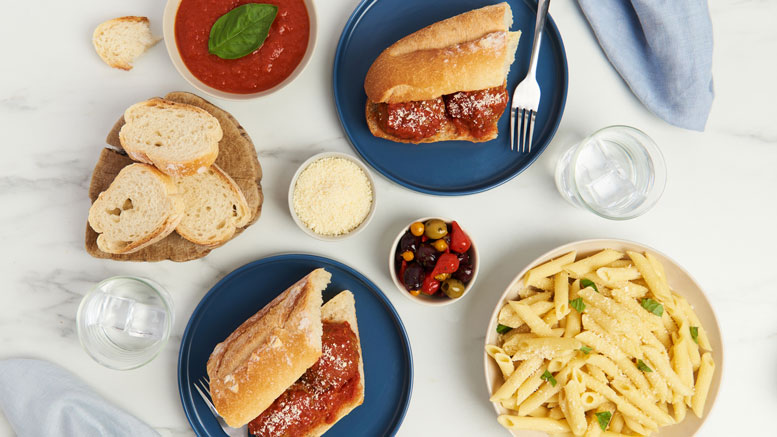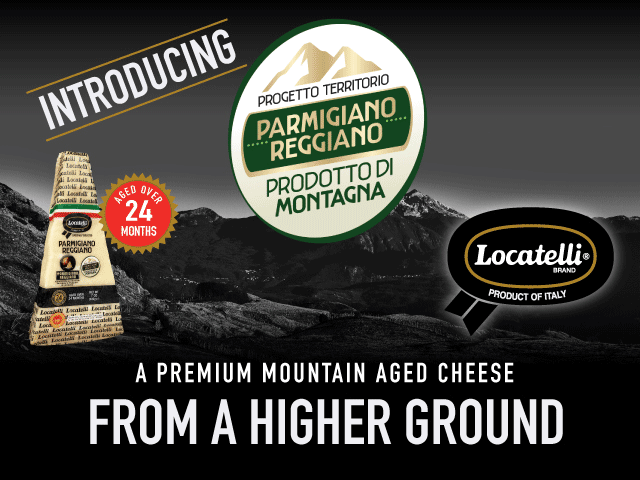That’s Italian!
January 14, 2025 | 8 min to read
The demand for authentic Italian cuisine is revitalizing supermarket delis, with an emphasis on traditional ingredients like cured meats, cheeses, and convenient meal solutions. Brands such as Smithfield Foods and Mama’s Creations are responding to consumer preferences for quick, quality meals and innovative packaging. Additionally, a focus on health, sustainability, and authentic flavors drives consumer engagement, highlighting the growing appreciation for Italian culinary traditions in grocery shopping.

A look at the latest Italian food trends in supermarket delis.
Italian cuisine continues to captivate American consumers, breathing life into supermarket delis where the demand for authentic flavors, quality ingredients and convenience is surging.
Today’s exploration reveals the vibrant trends and innovations transforming the Italian food segment in deli aisles, driven by the increasing consumer interest in Italian cured meats, cheeses, olives and other delicacies. More than just a passing fancy, these trends signal a deeper appreciation for Italian culinary tradition.
“The restaurant experience that consumers want to have at home is what is leading the charge for Italian solutions in the deli,” says Carl Zuanelli, founder and chief executive of Nuovo Pasta Productions, headquartered in Stratford, CT. “Whether that be the cheeses, the olives, the charcuterie, or most certainly, the pastas.”
THE ALLURE OF ITALIAN MEATS
Italian meats hold a special place in the heart of deli shoppers, reflecting both tradition and innovation. Smithfield Foods, with its Margherita portfolio, leads the charge, offering an extensive selection.
“We offer a wide variety of Italian meats, from Spicy Capicola to Prosciutto,” says Doug Baldwin, brand manager for the Smithfield, VA-based company. “Our new line, All-Natural Margherita presliced Italian meats called Charcuterie Cuts, launched this year with popular varieties like pepperoni and Genoa salami.”
Pepperoni stands as a staple in numerous American households, driving much of the category’s growth, Baldwin notes.
“Pepperoni has solidified its status as a category leader, becoming a go-to for charcuterie boards, snacks and pizza toppings,” he says. “The versatility of pepperoni resonates deeply with consumers.”
The rise of variety packs also caters to the desire for multiple meat options, enhancing snacking and meal solutions.
“Consumers are increasingly interested in variety, and multiple options allow them to curate personalized meals and grazing boards,” says Baldwin.
FRESH AND CONVENIENT
Another trend resonating with customers is fresh and convenient meal solutions. These are key drivers in consumer purchasing decisions. The latest offerings from brands, like Mama’s Creations, underscore this trend.
“At Mama’s Creations, we are a one-stop shop with a host of traditional and emerging Italian items,” says Adam Michaels, chairman and chief executive of the East Rutherford, NJ-based company. “We have a selection of fully cooked, ready-to-heat items like Beef Meatballs, Chicken Cacciatore and our new ‘on-the-go’ Meatballs in a Cup.”
These ready meals cater to the growing need for quick, yet satisfying, options.
“Consumers want meals that fit their busy lifestyles without sacrificing quality or flavor,” says Michaels.
The economic landscape also factors into this trend.
“Inflation is affecting many households, pushing consumers to seek cost-effective meals that provide restaurant-quality experiences at home,” says Michaels.
FLAVOR AND TRADITION
Flavor and authenticity are essential components of the Italian deli experience. Giuliana Pozzuto, marketing director at DeLallo Foods, Mount Pleasant, PA, emphasizes the importance of authenticity in a market flooded with options.
“Consumers want authentic flavors and stories behind their food,” she says. “Our new Italian tomato bruschetta, featuring diced Roma tomatoes, garlic, basil, and now a spicy version, aligns perfectly with this growing demand. People appreciate knowing the origins of what they eat.”
“Consumers want authentic flavors and stories behind their food.”
— Giuliana Pozzuto, DeLallo Foods, Mount Pleasant, PA
DeLallo’s offerings are designed to enhance the overall consumer experience.
“It’s not just about the product; it’s about the experience and connection that our ingredients foster,” adds Pozzuto. “For instance, our balsamic cheese glaze, made from authentic I.G.P. Balsamic Vinegar, appeals to those wanting genuine ingredients for their charcuterie boards.”
Nuovo Pasta Productions offers a Passport to Italy, featuring ingredients from the 21 regions of Italy and highlights them in its fillings.
“There’s a new generation that has a real desire in food and how it’s prepared, but there’s a convenience aspect, where no one wants to make this ravioli at home, but wants to be able to purchase it for a meal,” says Zuanelli.
Ficacci also captures the essence of Italian tradition with its olive offerings.
“Our olives are packaged using Modified Atmosphere Packaging (MAP), ensuring freshness without preservatives or artificial ingredients,” says Giuseppe Ficacci, the company’s marketing and sales director, Castel Madama, Italy. “Once people taste our olives, they recognize they are different — fresher and better. Quality is paramount for us.”
HEALTH AND SUSTAINABILITY
As consumers become more health-conscious, their food choices reflect a desire for wholesome, sustainable options. This paradigm shift is evident in the strategies of various Italian food brands.
Emanuela Bigi, marketing manager of Veroni, Correggio, Italy, notes the demand for healthier products has influenced the company’s entire approach. Veroni has achieved the “Humanely Raised Meat” claim for all its products, emphasizing a commitment to ethical sourcing.
“Consumers want to ensure that the food they buy comes from responsible sources, which is why our humane animal welfare practices resonate with them,” says Bigi.
The increased sensitivity toward health and wellness prompts brands to introduce lower sodium and no-nitrate options.
“One of our latest innovations is the Reduced Sodium Dry Salame takeaway tray,” says Bigi, noting appealing healthier options can address consumer preferences effectively. “We’re catering to emerging consumer trends that prioritize health and quality.”
INNOVATIVE PACKAGING
Packaging plays a crucial role in product success, especially within Italian deli offerings. According to Brandon Gross, senior vice president of brand for FOODmatch, New York City, NY, innovation is key.
“We strive for packaging that enhances convenience, while ensuring quality,” says Gross. “Our new brineless snack packs utilize modified atmosphere packaging technology to improve flavor while addressing consumers’ desire for on-the-go snacking.”
This innovation aligns perfectly with contemporary demands.
Ficacci shares similar sentiments, promoting sustainable practices in packaging design.
“Our paper packaging is recyclable and reduces plastic use by 87%, which is a significant step toward environmental responsibility,” he says. “The ready-to-use format offers practicality while maintaining our commitment to product quality.”
CROSS-MERCHANDISING
For brands within the Italian food sector, effective cross-merchandising can spark consumer interest and enhance purchasing behavior.
Baldwin of Smithfield Foods highlights the effectiveness of pairing various meats in deli displays. “Utilizing secondary displays during the holiday season allows consumers to see meal solutions,” he says.
Veroni also embraces this strategy, noting its collaborations with wine brands like Prosecco.
“We’ve created displays that emphasize pairing our charcuterie with delightful beverages, enhancing the overall consumer experience,” she says.
Cross-merchandising is about creating seamless experiences for shoppers — connecting products across categories leads to increased sales and customer satisfaction.
“At the deli, consumers expect ready-to-eat options, so these pairings create a more compelling offering,” says Baldwin.
CONSUMER ENGAGEMENT
Engaging consumers is critical for brands looking to promote new products. The International Dairy Deli Bakery Association (IDDBA) recommends in-store tasting events as an effective strategy for driving trial and purchase.
Whitney Atkins, vice president of marketing for the IDDBA, says, “Sampling different varieties creates excitement and allows customers to experience quality firsthand.”
Baldwin supports this approach, emphasizing the importance of education to help shoppers understand the value of Italian meats and cheeses.
“Informing consumers of the various uses for our products can help increase interest and drive sales,” he says. “Campaigns showcasing olives and meats as versatile and healthy additions to diets are essential.”
As the demand for Italian-themed gatherings grows, retailers benefit from offering knowledge alongside products.
Zuanelli feels social media and using QR codes on products are great ways to get the word out about Italian products.
CONSUMER PREFERENCES
As preferences evolve, brands are looking to create products that cater to specialized trends. At FOODmatch, Gross notes it’s expanding the selection of grab-and-go snacking options in 2025, responding directly to consumer demand for healthy, portable snacking.
For instance, the company has turned its attention to the growing interest in fermented and spicy options, exemplified by its Chopped Calabrian Peppers.
“These peppers have gained traction for their balance of heat and sweetness,” says Gross. “Home cooks and chefs alike appreciate their boldness.”
Similarly, the focus on sweet-spicy combinations aligns with a broader culinary trend. Mama’s Creations also heeds this shift in consumer preference, incorporating international flavors, while remaining true to their Italian roots.
“We introduced a Nashville Hot Panini that starts sweet but finishes with a kick, addressing consumer cravings for bold flavors,” says Michaels.
LOOKING AHEAD
The Italian food segment in supermarket delis is poised for ongoing transformation, with companies recognizing the importance of quality, convenience and health considerations.
With the Italian food market evolving, Ficacci anticipates further growth in demand.
“Consumers increasingly seek high-quality, healthy options,” says Ficacci. “As they become aware of the benefits of our fresh olives, the interest will continue to rise.”
With a commitment to quality, sustainability, and creative products, the Italian food sector is well-positioned for continued success in a competitive marketplace.
“We expect continued importance placed on clean labels, sustainable packaging and flavor innovation that introduces people to global cuisines, spices and ingredients,” says Gross. “At the end of the day, we are all looking to indulge in little luxuries that make our life simpler, more delicious, and that give us back a little of what we most value — time with family and friends.”
35 of 82 article in DeliBusiness Winter 2024-2025

